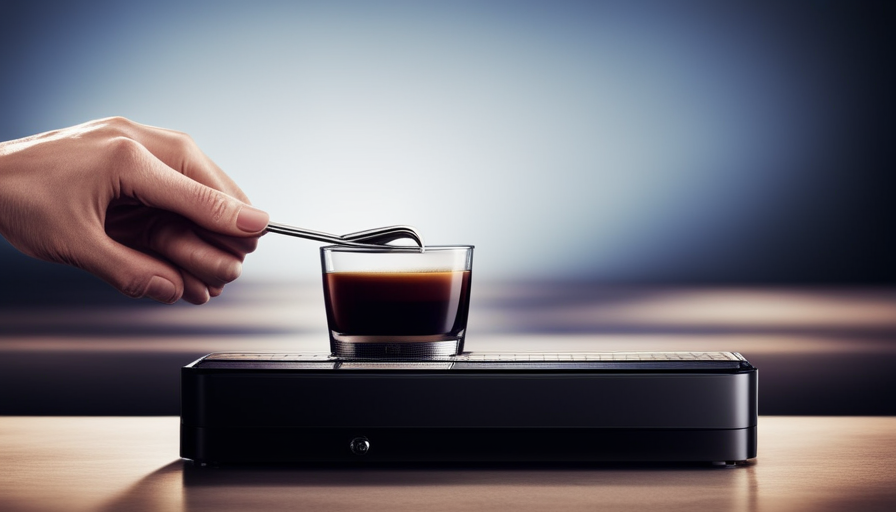Regularly removing scale buildup is essential for Nespresso machines to ensure optimal coffee taste and smooth machine operation. Neglecting this maintenance can lead to limescale buildup and internal corrosion, which may impact the quality of your coffee and shorten the lifespan of your machine.
To prevent these issues, it is recommended to descale your machine once a month if you are a regular coffee drinker, or every 3 to 6 months for occasional users. The descaling process takes approximately 15 minutes for Original Line machines and 20 minutes for Vertuo machines. It involves using a descaling kit, which typically includes two solutions, and following the specific instructions for your Nespresso machine model.
While the Nespresso descaler is recommended, citric acid or vinegar can be used as substitutes, with the latter requiring additional water cycles to remove the vinegar flavor.
By regularly descaling your Nespresso machine, you can maintain the optimal taste of your coffee and prolong the lifespan of your beloved appliance.
Key Takeaways
- Regular descaling is necessary to maintain coffee taste and machine performance.
- Neglecting descaling can lead to limescale accumulation and internal rust, compromising coffee quality and machine lifespan.
- Descaling should be done once a month for regular coffee drinkers or every 3 to 6 months for occasional users.
- Descaling kits typically include two solutions and specific instructions for the machine model.
Why descale regularly?
Regular descaling of Nespresso machines is essential to maintain optimal coffee taste and machine performance. It eliminates limescale build-up, prevents internal rust, and ensures the longevity of the machine. Descaling offers several benefits, including the removal of mineral deposits that can alter the flavor of the coffee.
Limescale, a common result of hard water, can accumulate in the internal components of the machine, affecting its efficiency and functionality. Descaling also helps to prevent rust formation, which can lead to corrosion and further damage.
The frequency of descaling depends on the individual’s coffee consumption. Regular coffee drinkers should descale once a month, while others can do it every 3 to 6 months. Adhering to a regular descaling schedule not only maintains the coffee’s optimal taste but also extends the lifespan of the Nespresso machine.
Descaling process instructions
Periodic descaling of Nespresso machines is necessary to ensure the longevity and proper functioning of the equipment.
Descaling offers several benefits. Firstly, it eliminates limescale build-up, which can negatively affect the taste of the coffee and hinder the machine’s performance. Additionally, descaling prevents internal rust, which could lead to further damage and decrease the lifespan of the machine.
The frequency of descaling depends on the individual’s coffee consumption. Regular coffee drinkers should descale their machines once a month, while others can do it every 3 to 6 months.
It is important to note that different Nespresso machines have varying descaling processes. For instance, Nespresso Vertuo machines require a 20-minute descaling process, while Original Line machines take 15 minutes.
Following the recommended descaling frequency and process will ensure optimal coffee taste and machine performance.
Substitutes for descaler
To maintain the longevity and performance of your Nespresso machine, it is essential to consider alternative methods for descaling. While Nespresso provides a specific descaling kit, some users may prefer to use citric acid or vinegar as substitutes.
Here are the pros and cons of using citric acid versus vinegar as descaler alternatives:
-
Citric Acid:
- Pros: Citric acid is a natural and effective descaler that can remove limescale buildup.
- Cons: It may be more difficult to find citric acid compared to vinegar, and it may not be as readily available in households.
-
Vinegar:
- Pros: Vinegar is easily accessible and affordable, making it a popular choice for descaling.
- Cons: The strong smell of vinegar may linger in the machine even after rinsing, and it may not be as effective as citric acid in removing tough limescale.
Ultimately, it is recommended to use the descaler provided by Nespresso to avoid any potential damage to the machine.
Frequently Asked Questions
How often should I descale my Nespresso machine if I only drink coffee occasionally?
Descaling is necessary to maintain optimal performance and coffee taste in Nespresso machines. For occasional coffee drinkers, descaling should be done every 3 to 6 months.
The descaling process typically takes 15 minutes for Original Line machines and 20 minutes for Vertuo machines.
Signs that your Nespresso machine needs descaling include a decrease in coffee temperature, slower brew times, and unusual noises during operation.
Regular descaling helps eliminate limescale build-up and prevents internal rust, ensuring the longevity of your machine.
Can I use citric acid or vinegar to descale my Nespresso machine if I don’t have the descaling kit?
Using alternative descaling solutions such as citric acid or vinegar can be done if the Nespresso descaling kit is not available. However, it is recommended to use the descaler provided by Nespresso to avoid potential damage to the machine.
Regular descaling is important to maintain optimal coffee taste and machine performance. Descaling eliminates limescale build-up and prevents internal rust.
It is recommended to descale the machine once a month for regular coffee drinkers or every 3 to 6 months for others.
Is it necessary to wait for the machine to dry after descaling before using it again?
It is advisable to wait for the Nespresso machine to dry after descaling before using it again. This allows any residual moisture to evaporate and ensures that the machine is completely dry before brewing coffee.
Waiting for the machine to dry is especially important when using the Nespresso descaling kit, as the solution contains chemicals that may affect the taste and quality of the coffee if not fully dried.
Moreover, allowing the machine to dry after descaling helps maintain its longevity and performance by preventing any potential damage caused by moisture.
Do all Nespresso machines have the same descaling process?
The descaling process for Nespresso machines varies depending on the model. Different machines may have slight differences in the steps and duration required for descaling. However, there are common steps that are followed for most Nespresso machines, such as using the descaling solution provided or using a substitute like vinegar, running the descaling cycle, and rinsing multiple times with water.
It is important to refer to the specific descaling instructions for each machine model to ensure proper maintenance and optimal performance.
What are the specific descaling instructions for Nespresso Lattissima, Creatista, and Essenza machines?
The specific descaling instructions for Nespresso Lattissima, Creatista, and Essenza machines are available on the Nespresso website. Descaling is of utmost importance for maintaining the optimal coffee taste. Regular descaling eliminates limescale build-up, prevents internal rust, and ensures the machine’s performance.
While the exact instructions may vary for each machine model, it generally involves:
- Using the descaling solution provided by Nespresso.nn2. Following the specified descaling process.nn3. Rinsing the machine thoroughly before reuse.
How Does Water Quality Affect the Need for Descaling in Nespresso Machines?
The importance of water for coffee cannot be overstated, especially when it comes to Nespresso machines. Poor water quality can lead to a build-up of limescale, increasing the need for descaling. Using high-quality, filtered water can help prevent this build-up and maintain the performance of your machine.
Conclusion
Regular descaling of Nespresso machines is crucial for maintaining coffee taste and machine performance. Descaling eliminates limescale buildup and prevents internal rust, ensuring optimal coffee quality. The process, which takes 15-20 minutes depending on the machine type, should be done monthly or every 3-6 months.
Using the Nespresso descaler is recommended, but substitutes like citric acid or vinegar can be used. After descaling, allowing the machine to dry for 10 minutes is important.
Proper descaling not only enhances coffee enjoyment but also prolongs the machine’s lifespan. As the saying goes, ‘Good maintenance ensures great coffee.’

















